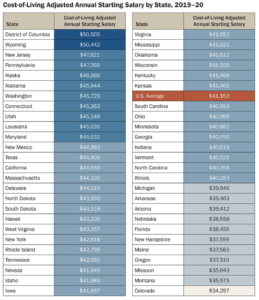Earlier this year, New Mexico Gov. Michelle Lujan Grisham called on National Guard members and state workers to serve as substitute teachers — a short-term effort to avoid closures and shifts to remote learning because of COVID-19-related absences. Gov. Grisham even filled in herself as a substitute kindergarten teacher for a day.
Examples like this highlight effects of the COVID-19 pandemic that have led to severe staffing challenges across the country. A 2021 RAND Corporation survey highlights that, in addition to the stresses of COVID-19 — such as longer working hours, concerns about contracting the virus and juggling child care responsibilities — teacher salaries also contributed to shortages. Indeed, among teachers under 40 years old who left the profession since March 2020, the top reason identified for their departure was that the pay was insufficient to merit the risks or stresses of the job.
In early 2022, policymakers in New Mexico responded to teacher shortages by passing two bipartisan bills to raise educator pay. In February of that year, the Legislature passed a bill that increased base salaries by an average of 20%. The base salary for beginning teachers increased from $40,000 to $50,000. The law also increased base pay for veteran teachers from $60,000 to $70,000. The 2022 state budget — passed in March — includes funding for an additional 7% average pay raise for the state’s teachers. The salary increases are part of the state’s long-term strategy to improve teacher recruitment and retention.
New Mexico is not alone in rethinking teacher pay. Mississippi legislators recently passed the largest teacher pay raise since the 1980s, which increased the state’s base starting salary by 12%. Current teachers will also receive an average pay raise of $5,140. Other states are also considering raises in light of teacher shortages.
Taking Stock of Salaries
A state-by-state analysis developed by the Learning Policy Institute examines starting salaries, starting salaries adjusted for cost of living and teacher wage competitiveness. The data shows that teachers’ salaries generally lag behind those of other college-educated workers but vary greatly from state to state.
While the average starting teacher salary nationally was $41,163 in 2019-20, California, New Jersey, Washington and the District of Columbia had average starting salaries above $49,000. In Missouri and Montana, average starting salaries were less than $35,000, which highlights the wide range of salaries, although the amount itself is not directly comparable across states.
The value of teacher salaries depends on the cost of living in each state. For example, Mississippi — with an unadjusted average starting salary of $36,543 — has one of the lowest average starting salaries in the country. However, with a lower cost of living than most other states with similar salaries, Mississippi ranks 28th in average starting salary once adjusted for cost of living.
Note: Annual starting salary is defined as the salary paid to a teacher with a bachelor’s degree and no prior experience. Annual starting salaries were collected by the National Education Association from district teacher salary schedules or district compensation plans.
State cost-of-living adjustments are calculated using Regional Price Parities from the U.S. Bureau of Economic Analysis. Regional Price Parities are generated using average price quotes for a wide array of items from the Consumer Price Index such as apparel, education, food, housing, medical, recreation, transportation, and other goods and services. Regional Price Parities are expressed as a percentage of the overall national level. The national average starting wage for teachers does not get adjusted.
Annual starting salaries and cost of living also vary by district, so within states there are locales that offer adjusted starting salaries that are higher and lower than the state average.
Sources: NEA 2019-2020 Teacher Salary Benchmark Report; U.S. Bureau of Economic Analysis, Regional Price Parity Indices 2020.
Understanding Teacher Wage Competitiveness
When understanding teacher pay, another consideration is whether salaries are competitive compared to other career choices. The Economic Policy Institute developed a metric for wage competitiveness which measures how much public school teachers earn weekly compared to other college educated workers. Their estimates use weekly wages, rather than yearly or hourly wages, to account for teachers’ shorter contracts, while controlling for worker characteristics.
Economic Policy Institute’s metric shows that, nationally, teachers earn about 80% of what other college educated professionals earn each week. In New Jersey, Rhode Island and Wyoming, teachers are estimated to make over 95% of what similarly educated non-teachers make. In Arizona and Virginia, teachers earn, on average, less than 70% of what their non-teacher counterparts earn.
Challenging salary conditions are prompting policymakers to raise teacher compensation as one of many strategies to build a strong and diverse workforce. While teacher pay levels are decided at the district and state level, federal policies can also improve the economic livelihood of teachers. For example, tax credits for teachers and updating and enhancing existing federal grant and loan programs could increase teacher incomes on a national level.
Stay tuned for the next post in this series that highlights four ways state leaders can lower teacher pension costs.





